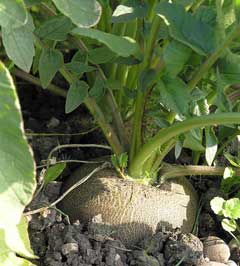
Oriental Radish
Latin Name: Raphanus sativus niger
USDA Hardiness: 2-11
Native Range: (Raphanus sativus) Greece, Italy, Sicilia, Yugoslavia.
Edibility Rating: 4 / 5
Medicinal Rating: 3 / 5
Region:
Family:
Plant Type:
Medicinal Uses
Edible Uses
Edible Parts: Flowers Leaves Oil Root Seed Seedpod | Edible Uses: OilYoung leaves - raw or cooked[37, 52, 104, 183]. A somewhat hot taste, and the texture is somewhat coarse[K]. As long as they are young, they make an acceptable addition in small quantities to chopped salads and are a reasonable cooked green[K]. A nutritional analysis is available[218]. Young flower clusters - raw or cooked[183]. A spicy flavour with a crisp pleasant texture, they make a nice addition to salads or can be used as a broccoli substitute[9, K]. Seeds - raw. The seed can be soaked for 12 hours in warm water and then allowed to sprout for about 6 days[244]. They have a hot spicy flavour and go well in salads[183, 244]. Young seedpods - raw[2, 37, 52, 104]. Crisp and juicy with a mildly hot flavour[K]. They must be eaten when young because they quickly become tough and fibrous[183]. Root - raw or cooked[2, 37, 52]. Large, crisp and juicy, many varieties have a hot and spicy flavour, though there are also many of the Oriental forms with much milder flavours. They can be sliced and eaten in salads or can be cooked in soups etc. The roots store well and can be either harvested in early winter for storage or be harvested as required through the winter[K]. An edible oil is obtained from the seed[2, 183].
Cultivation
Prefers a rich soil with ample moisture[16, 52]. Dislikes very heavy or acid soils[16, 37]. Some of the Oriental radish cultivars have been selected for growing in clay soils, the swollen part of the root is formed on the soil surface[206]. Plants are susceptible to drought and require irrigation during dry spells in the summer or the root quality will rapidly deteriorate and the plant will go to seed. The Oriental and winter radishes are often cultivated for their large edible roots, which can be available from mid summer and all through the winter. There are many named varieties. The plants are very winter hardy and can normally be left in the ground all winter to be harvested as required, though slugs might cause some damage to the roots. Radishes are a good companion plant for lettuces, nasturtiums, peas and chervil, tomatoes and cucumbers[18, 20]. They are said to repel cucumber beetles if planted near cucumber plants and they also repel the vine borers which attack squashes, marrows and courgettes[238]. They grow badly with hyssop[18, 20] and with grape vines[201].
Known Hazards
The Japanese radishes have higher concentrations of glucosinolate, a substance that acts against the thyroid gland. It is probably best to remove the skin[160].
Habitats
Not known in the wild.